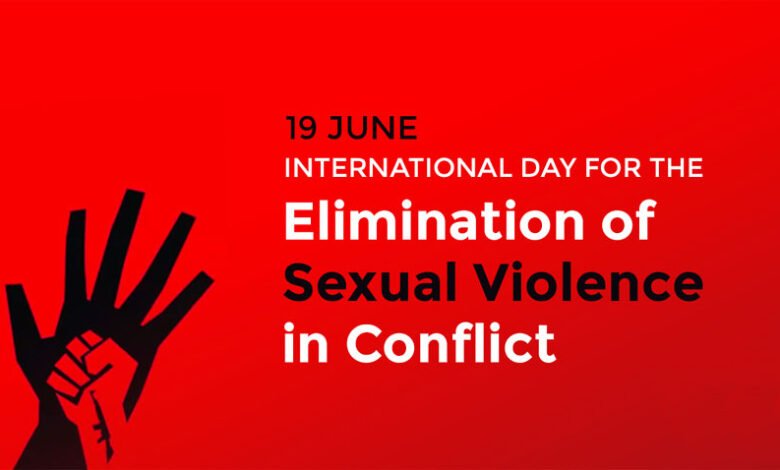Breaking the Silence: A Global Call to End Sexual Violence in Conflict

During conflicts, women and children are most vulnerable and are often sexually abused. That is why the United Nations (UN) designated June 19 as the International Day for the Elimination of Sexual Violence in Conflict.
The essence of this observation is to increase awareness of this crime and to develop strategies for ending it globally. The UN Security Council condemned sexual violence as a tactic of war and a barrier to peacebuilding.
Conflict-Related Sexual Violence Definition By The United Nations
According to the United Nations, “conflict-related sexual violence” includes rape, forced prostitution, forced pregnancy, forced abortion, forced sterilization, forced marriage, and any other form of sexual violence of comparable gravity.
It also encompasses human trafficking carried out for purposes of sexual exploitation or assault during conflict. These acts, whether directly or indirectly linked to conflict between parties, constitute “conflict-related sexual violence” against women, men, girls, or boys.
According to statistics, over 95% of the 3,622 cases reported involved women and girls who are disproportionately affected by conflict-related sexual violence. Children were affected in 1,186 of these cases, with 1,157 (98%) of them being girls. The data also shows that 145 cases (4%) involved men and boys, highlighting that they, too, are subjected to sexual violence during conflicts.
Sexual violence has equally generated profits for armed and violent extremist groups while undermining women’s livelihoods and limiting girls’ access to education.
However, several laws such as the Convention on the Rights of the Child, the Geneva Conventions and Additional Protocols, and the Optional Protocol to the CRC on the Involvement of Children in Armed Conflict protect the rights of children during conflicts. These laws protect them from abuses like assault, recruiting them as child soldiers, or even sexually abusing them. This includes bans on assaulting them, enlisting them in the military, and sexually abusing them. Rather, they are to be cared for and shielded from the effects of war.
2025 Theme of International Day for the Elimination of Sexual Violence in Conflict
The theme for this year’s observance is “Breaking the Cycle, Healing the Scars: Addressing the Intergenerational Effects of Conflict-Related Sexual Violence.” The theme aims to inspire, educate, and give hope as people globally raise their voices to to end rape in war.
This year’s focus is on the severe and lasting trauma that conflict-related sexual violence causes across generations.
History of the International Day for the Elimination of Sexual Violence in Conflict
Sexual violence has long been a tragic consequence of war, often met with silence. One of the earliest attempts to legislate against such violence during armed conflict was the Lieber Code, issued in February 1863 during the American Civil War. It listed rape as a capital offense and specifically recognized sexual assault as punishable.
Later, however, the word “rape” was removed from legal language in favor of references to an attack on the “honor of the family.” This shift reappeared in the 1949 Fourth Geneva Convention, which referred to the “honor” of women and reintroduced rape as an example of such an attack, identifying women and girls as individuals in need of protection.
Since its inception, the International Committee of the Red Cross (ICRC) has opposed the horrors of war. However, it wasn’t until the late 1990s that the ICRC began actively addressing sexual violence during armed conflicts. The Second Additional Protocol to the Geneva Conventions, adopted in 1977, prohibits “outrages upon personal dignity, rape, enforced prostitution, and any form of indecent assault” against persons not participating in hostilities, applicable at all times and in all places.
This international day also serves as a reminder of the urgent need to empower and protect women and girls and to save lives by preventing gender-based violence, especially in light of rising gender-related killings in recent years. Moreover, it honors the memory of those affected and pays tribute to those who have given their lives in the struggle to end sexual violence.
The Impact of Conflict on Children
Children’s lives are severely disrupted by conflict, which affects their mental, emotional, and physical well-being. Often, the most vulnerable victims, childre,n face immediate dangers such as family separation, violence, and displacement. In such settings, their basic needs—such as food, shelter, and medical care—are frequently unmet.
Furthermore, the psychological effects of conflict can take many forms, including anxiety, depression, and trauma. Many children witness or experience horrific events, leaving them with emotional scars that can last a lifetime. This trauma may hinder their development and long-term potential, further entrenching cycles of poverty and conflict.
Education is another critical area negatively impacted by conflict. Ongoing violence, especially when directed at schools, may force children to drop out. Deprived of educational opportunities, they miss out on acquiring essential skills needed for reintegration into society, placing their future at risk and contributing to long-term instability.
Effective conflict resolution requires a deep understanding of how conflict affects children. To mitigate these impacts and ensure children’s voices are included in peacebuilding efforts, strategies that prioritize child rights must be implemented.
Strategies for Protecting Children’s Rights During Conflicts
Safeguarding children’s rights in conflict situations requires a multifaceted approach involving institutional support, community engagement, and legal frameworks. These efforts aim to protect children’s physical, emotional, and psychological well-being.
A key component is the implementation of international agreements like the Convention on the Rights of the Child, which outlines fundamental child rights.
NGOs and organizations such as UNICEF also play a crucial role by working with local communities to deliver essential services like healthcare, education, and psychosocial support.
Community-based mechanisms, such as child protection committees, help monitor and address rights violations. These grassroots efforts empower families and communities to advocate for children’s rights and promote their safety during conflict.
Why Is International Day for the Elimination of Sexual Violence in Conflict Important?
a. It raises awareness.
The day’s core objective is to spread global awareness about the crime of conflict-related sexual violence. It encourages people to speak out against such atrocities.
b. It raises hope for a brighter future.
This observance aims to inspire hope and collective action toward a future in which children and women can live in safety. It urges us all to contribute to building a more just and peaceful world.
c. It draws attention to critical issues.
The day sheds light on pressing social issues and how conflict and unstable domestic situations can lead to horrific crimes against women and children. It reminds the world that these crimes are too often overlooked or ignored and calls for urgent attention and action.
Recommendations for Protecting Children During Conflict
- During conflict, children should not be denied access to education to reduce their vulnerability to exploitation.
- People who sexually abuse children should be held accountable to serve as a deterrent to others.
- Communities create safe environments for children, including safe spaces during displacement.
- Children affected by conflict should be supported through reintegration programs.
- Child protection should be integrated in humanitarian responses, and personnels trained to identify and respond to abuse.
Conclusion
The International Day for the Elimination of Sexual Violence in Conflict calls for an urgent need to protect women and children, who continue to bear the brunt of sexual violence in times of war. Also, to prioritize their safety and dignity. Let this day renew our global commitment to prevention, protection, and healing.





